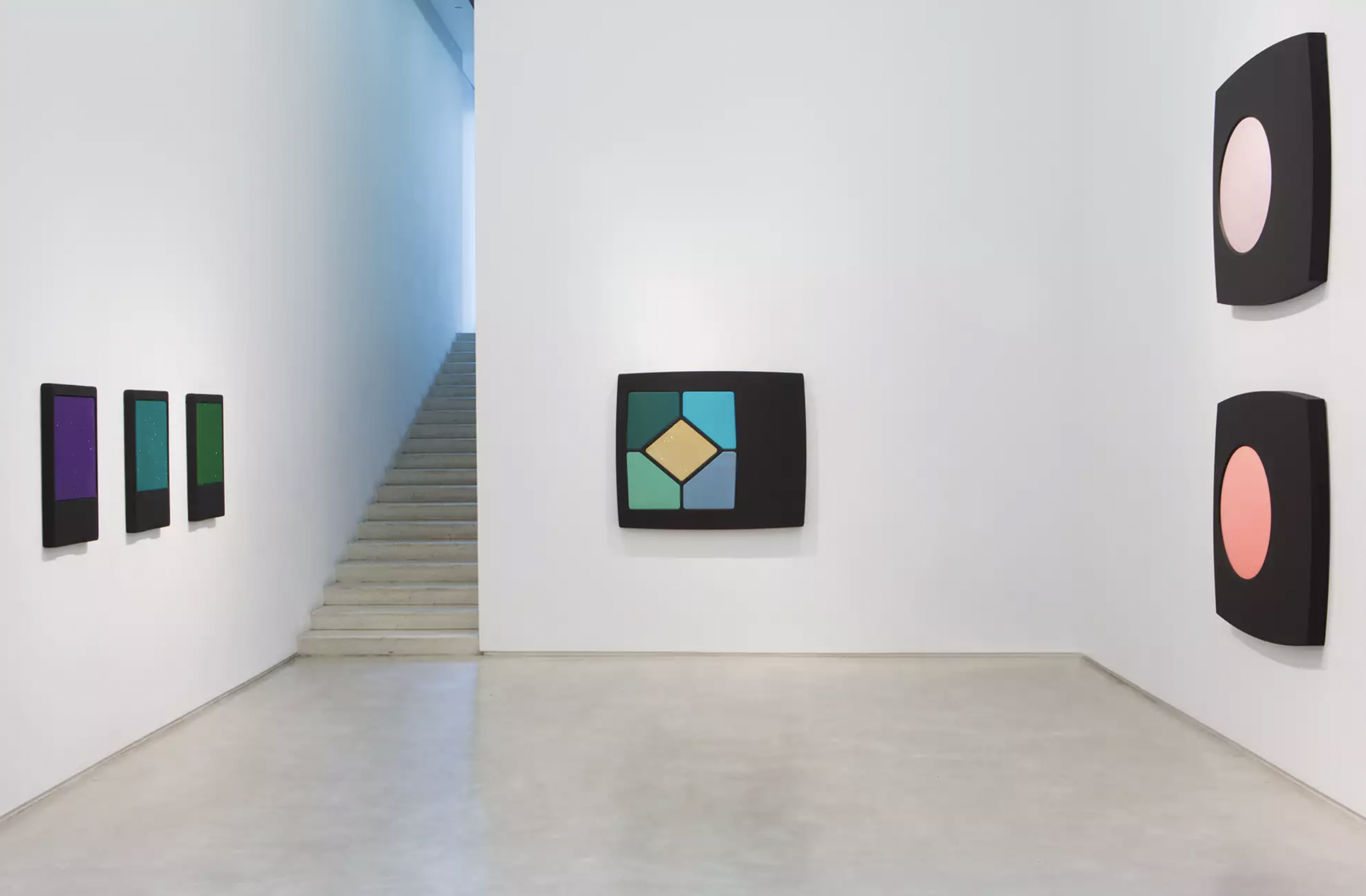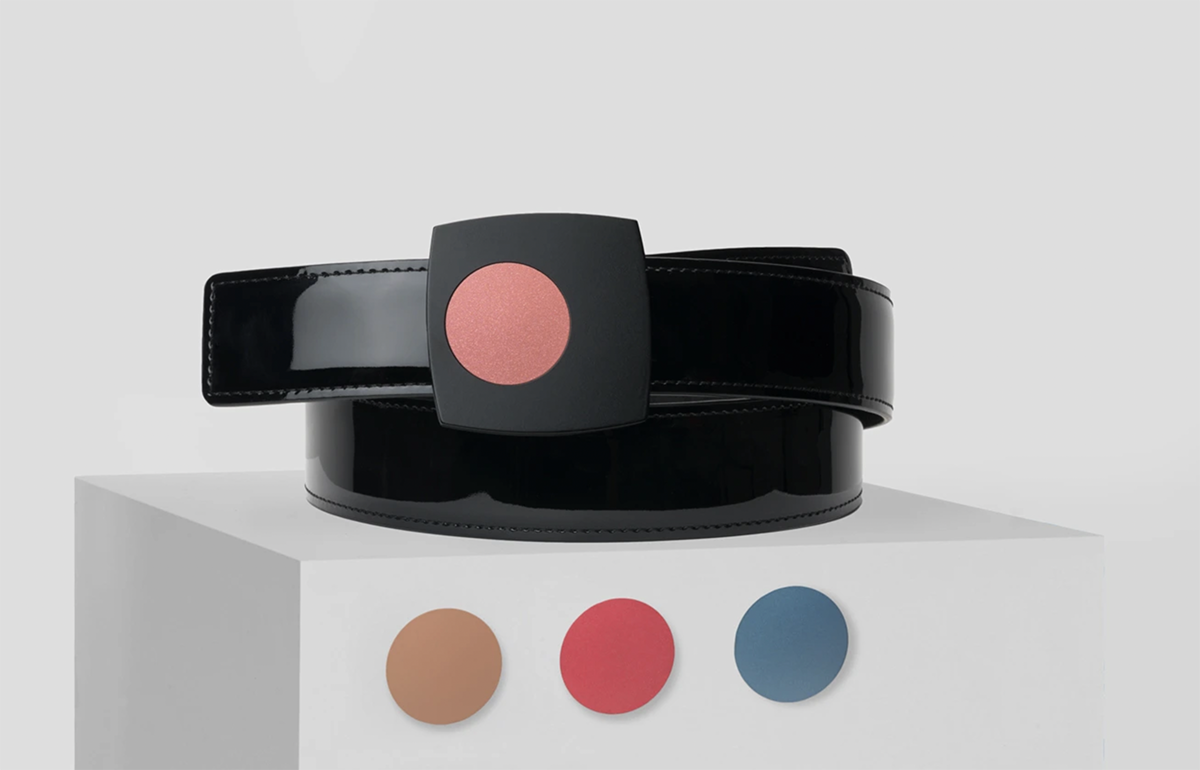Multimedia artist Sylvie Fleury (b. 1961; Switzerland) is truly speaking my language. While her works involving fashion, rockets, and neon signs are certainly thought-provoking, it's Fleury's larger-than-life reproductions of makeup products that will be the focus of this post.
Fleury has long used cosmetics as a creative catalyst, providing an uncannily prescient commentary on makeup in the age of social media. A full decade before the popularity of makeup destruction ASMR videos, Fleury crushed several piles of assorted products with a Buick Skylark on a gallery floor. Her 1992, is reminiscent of today's haul and unboxing videos. And "Happy Clinique" (1998) could be considered a precursor to makeup swatch photos.
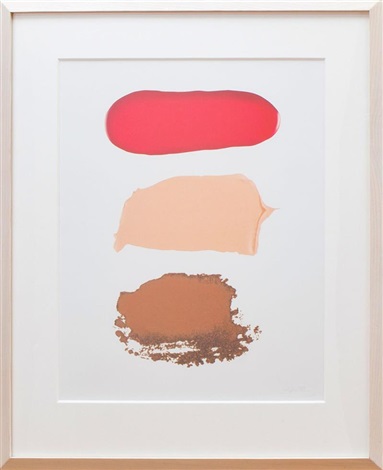
(image from artnet.com)
In 2017 Manhattan gallery Salon 94 opened a solo exhibition entitled Eye Shadows, and this group of works further honed the recurring themes of consumerism, art history, beauty standards, gender and the commercialization of art. In an interview with Vogue that year, Fleury explains how she arrived at supersizing makeup. "One day, after having seen these compacts for all these years, suddenly I realized, in fact, they are really good abstract paintings! My practice often takes me in the way of the ready-made, or there is often a temptation to do new things by reshowing what is already part of our world. But at the same time it’s about making abstract painting; it is also figurative because [the work] depicts something that exists, an object."1
Naturally, my personal opinion is that Fleury is a staunch ally in the makeup-as-art stance. By taking makeup out of its usual contexts – stores, purses, vanities, etc. – and placing it in an art gallery, along with other tactics, Fleury transforms cosmetic objects into literal art while acknowledging its base nature as a commodity.
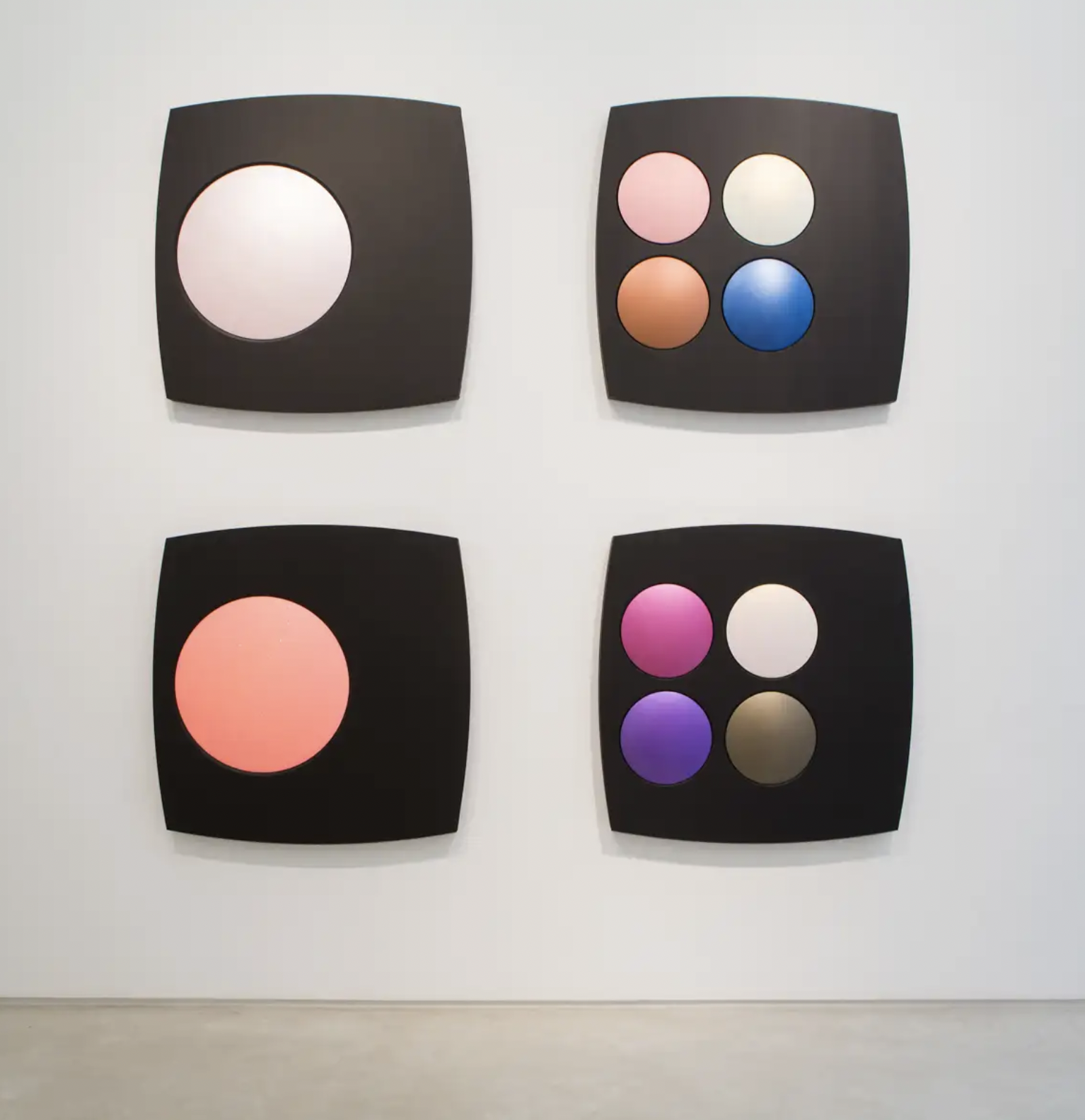 (image from salon94.com)
(image from salon94.com)
It's no accident that the brushes typically accompanying luxury makeup products are removed. While many lower-priced makeup lines omit them regularly as a cost-saving measure, some mid- and higher-end makeup lines occasionally do this as a way of encouraging creativity in the user rather than ascribing to usual application methods. In their 2021 collaboration with MAC, for example, designer Harris Reed noted that brushes were deliberately left out of the collection's products: "Nothing is in a tube and nothing has a brush. It's really all very much like an artist palette." Going back further, Vincent Beaurin's Tablettes de Bastet palette for Dior, with its heavy stone slabs and primary colors, evokes ancient art materials and the ritualistic aspect of applying makeup. While any makeup aficionado can easily recognize the individual brands (if not the exact products) the lack of visible brand names is another key element in the transformation from consumer good to means of self-expression and objet d'art.
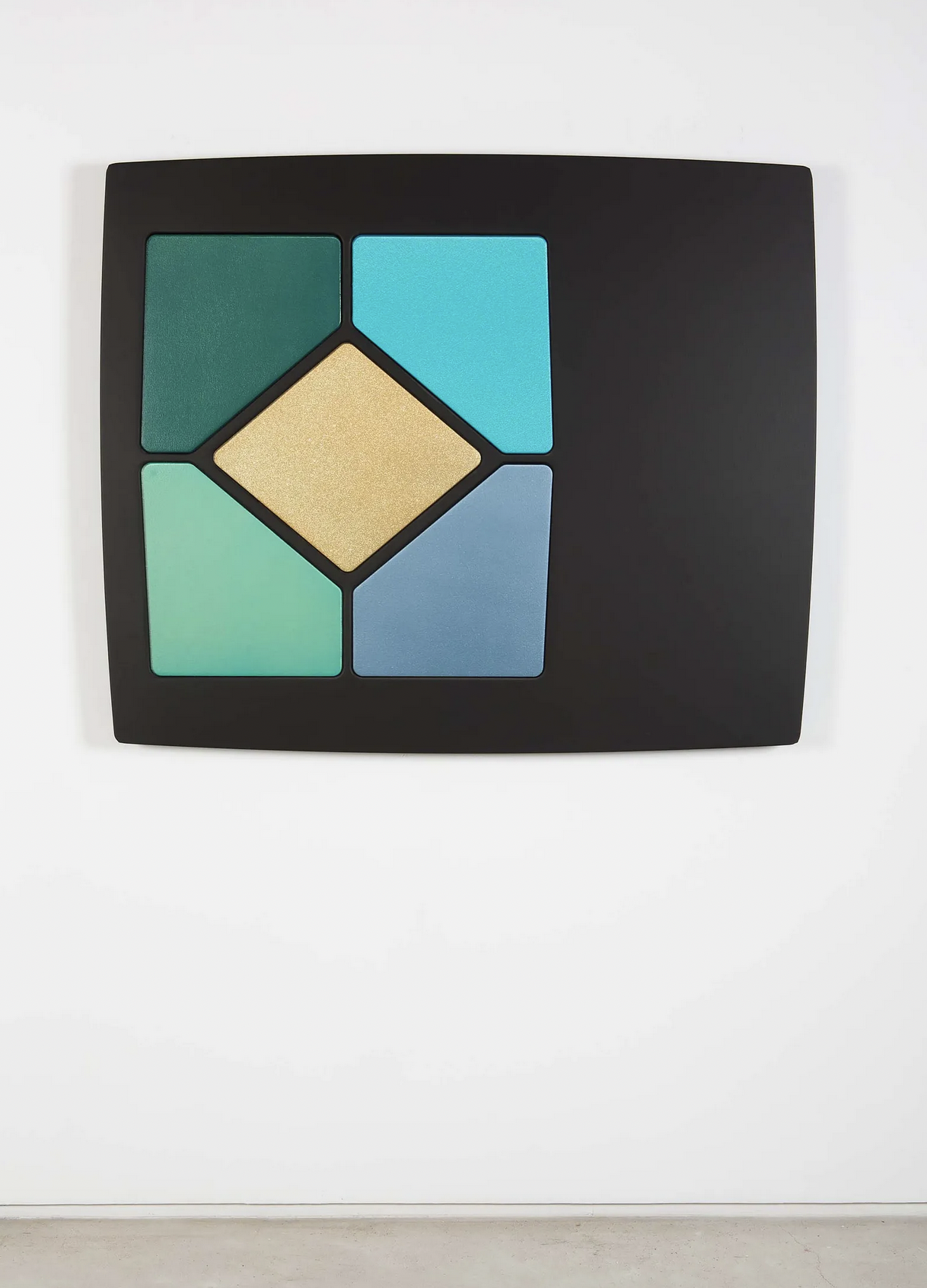 (image from vogue.com)
(image from vogue.com)
Along with ridding the makeup of visible branding and brushes, Fleury deliberately chooses to leave out what is usually considered an essential part of a cosmetic compact. The lack of mirrors forces the viewer to focus on their own interpretations of the piece rather than as a makeup product. No mirrors, she says, "was a purposeful choice, because in most cases, art already functions as a mirror…when you look at something, you are taken back to wherever you are in your own head." In some cases the viewer, depending on their shopping habits and whether they wear makeup, also contemplates their relationship with beauty standards and consumerism. As Alex Beggs ponders in a 2017 article for Vice, "If you blow up a makeup compact, something usually stowed away in the pockets of a purse, to bring viewers face to face with it, they'll begin to see something beyond the pigments. Am I unhealthily obsessed with painting my face? Or maybe I'm not appreciating how much beauty exists within the product itself? Are haul photos making me high? Do I have a Tom Ford lipstick fetish? Am I assigning value and meaning to bronzer based on its shiny black package? Do the round symmetrical shapes of the palettes signify some perfection I'll never attain?" Fleury's work blurs the line between fine art and makeup and in doing so, allows for deeper analysis of both worlds.
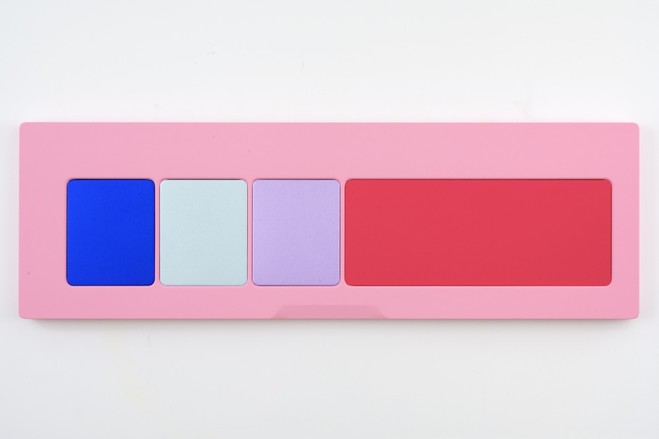
(image from dreamideamachine.com)
Though simple compositions, the paintings require elaborate and time-consuming work to complete. Fleury explains that she carefully paints precise layers of acrylic and uses a combination of matte and shimmer paint, sometimes adding glitter flakes to create exact replicas of makeup's many textures as well as that of the container itself. The painstaking process and resulting surfaces speak not only to the tactile nature of makeup – one visitor at the Eye Shadows exhibition confessed she wanted to put her hands across the paintings – but to women's labor in trying to meet traditional beauty standards. The artist's brushwork "achieves the smooth lines and surfaces of factory-manufactured goods, while simultaneously mimicking the ritualistic application of make-up, suggesting the pursuit of the perfect 'finish'." The process also serves as a reminder that makeup application, historically performed mostly by women and therefore perceived as a frivolous activity, parallels the lack of respect for women artists more generally. Fleury's response to this long-held patriarchal view was arguably voiced in a work at her first solo show in 1992. Entitled "Private Lessons," Fleury played a video tape of a makeup tutorial she had purchased from Bloomingdale's as a "comment on the male-dominated paradigms through which we define skill and artistry."

(image from ropac.net)
Fleury challenges the patriarchal tradition of male artists, or, "playfully redefines the canon in a decidedly feminine voice." By rendering makeup palettes in the same styles as art movements "pioneered" by men (Abstract, Color Field, Op Art, Pop Art, etc.), Fleury reminds the viewer of women's oft-ignored contributions to art history.2 In particular, some of the works in her 2018-2019 Palettes of Shadows exhibition served as a direct response a 1964 Guggenheim show of all-male artists: Paul Feeley, Sven Lukin, Richard Smith, Frank Stella, and Neil Williams contributed to The Shaped Canvas, an exhibition featuring sculpture/painting hybrids that play with shape and space, questioning the tradition of the two-dimensional, rectangular canvas in painting. Fleury's pieces, particularly the Chanel replicas, are curved to perfectly mimic the lines of the palettes as well as the rounded individual shades. "In her exhibition, Fleury has reduced and simplified the forms of femininity so that, for instance, a makeup palette becomes a pink sphere in one painting…through the clear dialogue she’s entered into with midcentury Pop Art, she questions these seemingly masculine stylistic modes, which, in addition to being gendered, also tend to be viewed as symbols of power. By putting her art into conversation with the aforementioned artists, Fleury has implicitly laid her own claim to their power — makeup and traditional femininity are, she ultimately implies, legitimate forms of power in their own right."
 (image from ropac.net)
(image from ropac.net)
When gathered in a single painting, all of these elements – along with the lack of mirrors, brushes and obvious branding – collectively work together as a feminist response to the art history canon and rejects the misguided notions that makeup is shallow, is not art and does not belong in a museum/gallery. Fleury's work emphasizes that makeup's historic, cultural and artistic value literally extends beyond the store, and demonstrates that makeup artistry and the objects used to create it do indeed belong in spaces traditionally intended for fine art. In a 2019 interview with WWD, Fleury reiterates the importance of makeup and fashion in creating a serious discourse about broader issues. "In the Nineties, they felt that fashion was a lower kind of art. When I first started showing my work I got criticized for incorporating elements of beauty and makeup, but I wanted to show that it's not superficial and in fact, you can use fashion and beauty to talk about feminism, politics and consumerism."
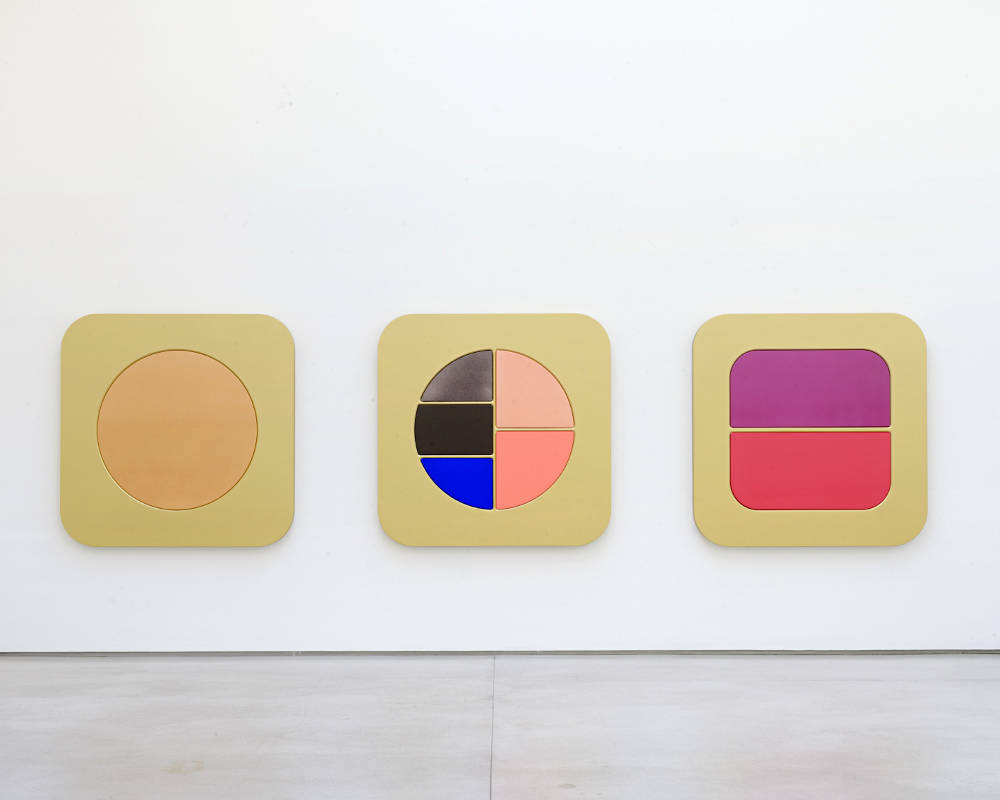 (image from galleriesnow.net)
(image from galleriesnow.net)
Along those lines, the works highlight the gatekeeping and snobbery so prevalent in the art and fashion worlds. "When I used bags from places where it was cool to shop at the time, it was also a way to refer to the art market and to the fact that gallery only exhibited artists whose names appeared in Artforum," Fleury recalls.
The paintings also challenge makeup's ephemeral nature and the latest barrage of products and shades. States the press release for the Eye Shadows exhibition, "Fleury has long been interested in the way the makeup industry discards the 'new,' mere months after a long and extensive research process into textures, colors, and names. The attributes the cosmetics industry takes into consideration when developing a product, Fleury argues, are not dissimilar to those an artist may consider when creating a new body of work. But while makeup is wiped clean nightly, art is meant to exist for eternity… these works point to the fleeting and cyclical essence of fashion and advertising. They hint at society’s broader concerns with temporality and permanence, and the disposability or temporary nature of value in contemporary society: the utopian promise has a pre-determined, seasonal shelf-life." By positioning cosmetics as permanent art objects, Fleury both acknowledges and resists the temporary nature of makeup, capturing its essence as a legitimate art medium.
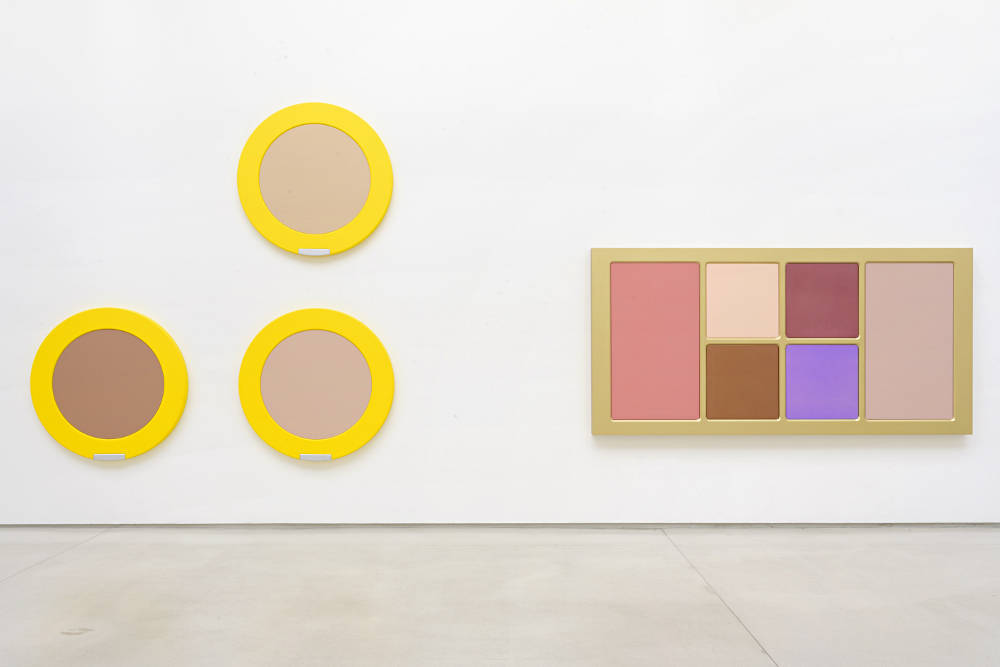
(image from galleriesnow.net)
Perhaps the most crucial element in Fleury's metamorphosis of makeup into art is size. The monumental scale of these works could be perceived not only as a disruption of white male supremacy in art history nor as makeup's cultural and historical importance writ large, but also a reclamation of the space that the patriarchy has repeatedly told women they either don't belong in (in the case of "high" art and art history) or not supposed to take up more generally. Along with Fleury's self-description as a "punk feminist in disguise", I can't help but be reminded of Riot Grrrl's rallying cry of "girls to the front!". Their endeavors to carve out physical space for women at shows, figurative space within the male-dominated punk scene and society as a whole used entirely different tactics from Fleury, but the sentiment is very much the same.
Occasionally, however, Fleury's approach can veer into the trap of the gender binary. "Patriarchal, capitalist societies always fear women’s desire and creativity. What I was and still am interested in, is eliminating as many boundaries in as many fields as possible. My practice of referencing iconic artworks comes, amongst other things, from a desire to balance the gender of artworks. I freely select an iconic, male artwork and inject my yin into the yang. I think much of my work stems from this idea of rebalancing opposing views, lifestyles, attitudes – seeing also where these can meet sometimes." I think Fleury does a bit of disservice to herself with the phrasing of "balance the gender" and "yin into the yang", as her work is more complex than the rather simplistic view of gender she discusses here. The dichotomy of masculine/feminine somewhat undermines the fact that plenty of men and non-binary people wear makeup.
The size of the makeup palettes is also a commentary on the power these tiny objects have, our overwhelming desire for them and all-encompassing consumerism of our daily lives. Fleury states, "Why has consuming become such a big part of our world, and how did it become to be so? I see myself as a sensible woman, yet I can have these huge craving for new things, sometimes just by looking at (makeup) boxes…I have the wisdom to know I am being seduced; yet I’ll ask, should I deprive myself?" While the brands aren't visible, Fleury often uses the shade or product names as titles, further highlighting their seductive appeal. "All of these cosmetics have such amazing names; there’s a lot of literature on the boxes. For instance, the Chanel ones, they are called Multi-Effect [eyeshadow], and there’s the name of the collection and then each of the colors…the round one that’s all black is called Eyes to Kill—a perfect little title," she says.
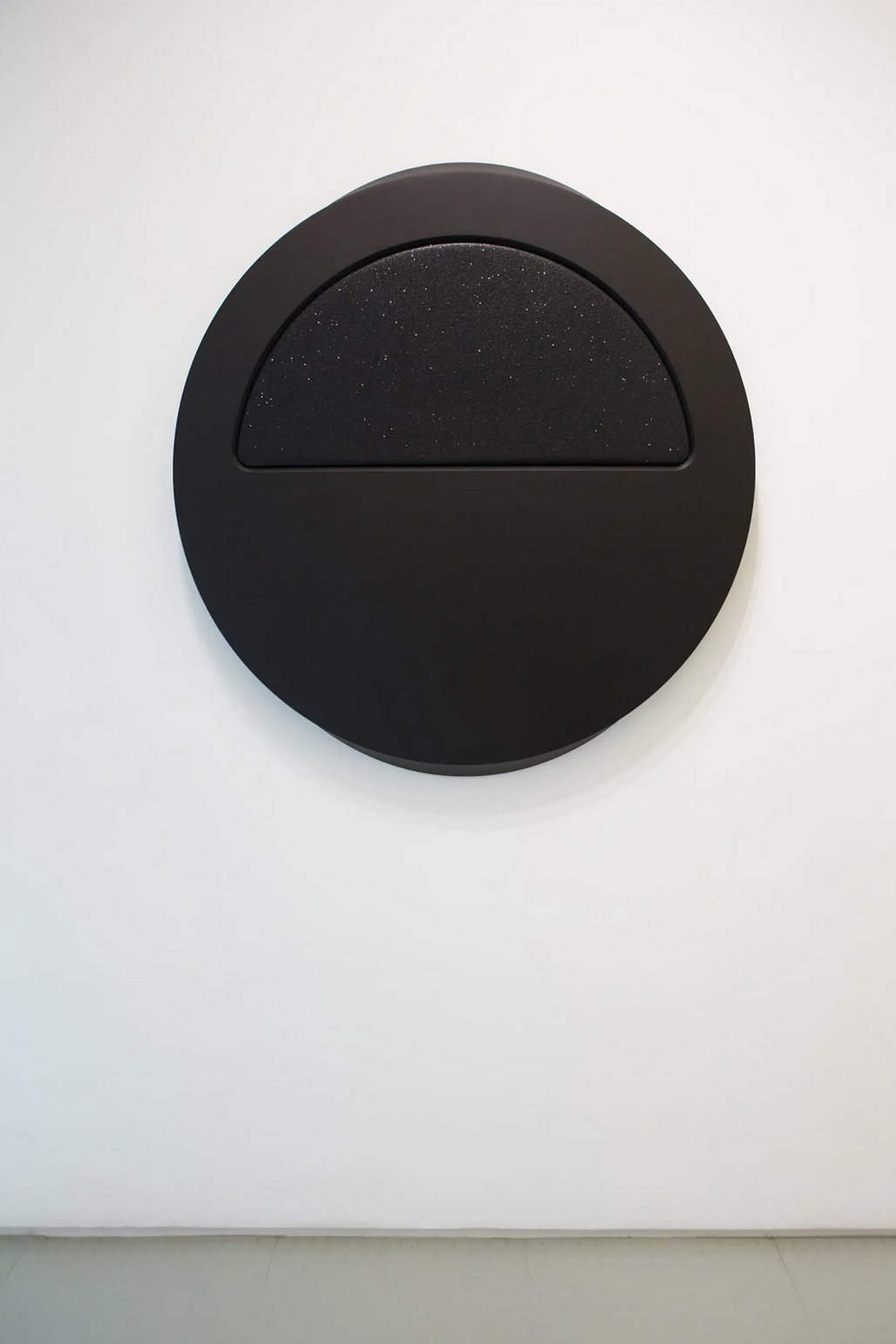 (images from salon94.com)
(images from salon94.com)
Fleury's makeup paintings function as a simultaneous criticism of consumer culture and a celebration of our desire for certain objects; they are ambivalent towards the fetishization of commodities3. On the one hand Fleury seemingly endorses the power that objects have, especially those usually purchased by women. Citing fellow art historian Peter Weibel, Barbara Hess points out that "[while] there are countless works of art that legitimise male pleasures, there are hardly any that celebrate the indulgences of women in like manner."4 Adds Alexander Gawronski: "Some of the artist's own statements contradict this absolutely sounding like unapologetic identifications with global commodity culture: 'I urge the audience to enjoy! Whatever they must do to get their kicks'".5 On the other hand, Fleury says she hopes viewers of Eye Shadows and similar works will get "the feeling of satisfaction without having to consume," perhaps recognizing the harm that can result from constant over-buying of the latest non-essential items. Observes Laetitia Queryanne, "The obsession and addiction to newness functions perfectly to perpetuate the cycle of consumption, since its intangibility and ephemerality constantly leave one wanting more. And this 'wanting more' is precisely what the work of these artists expose, the desire for and yearning for fulfillment via an object or a commodity clearly reflect a serious dysfunction of contemporary consumer society."6
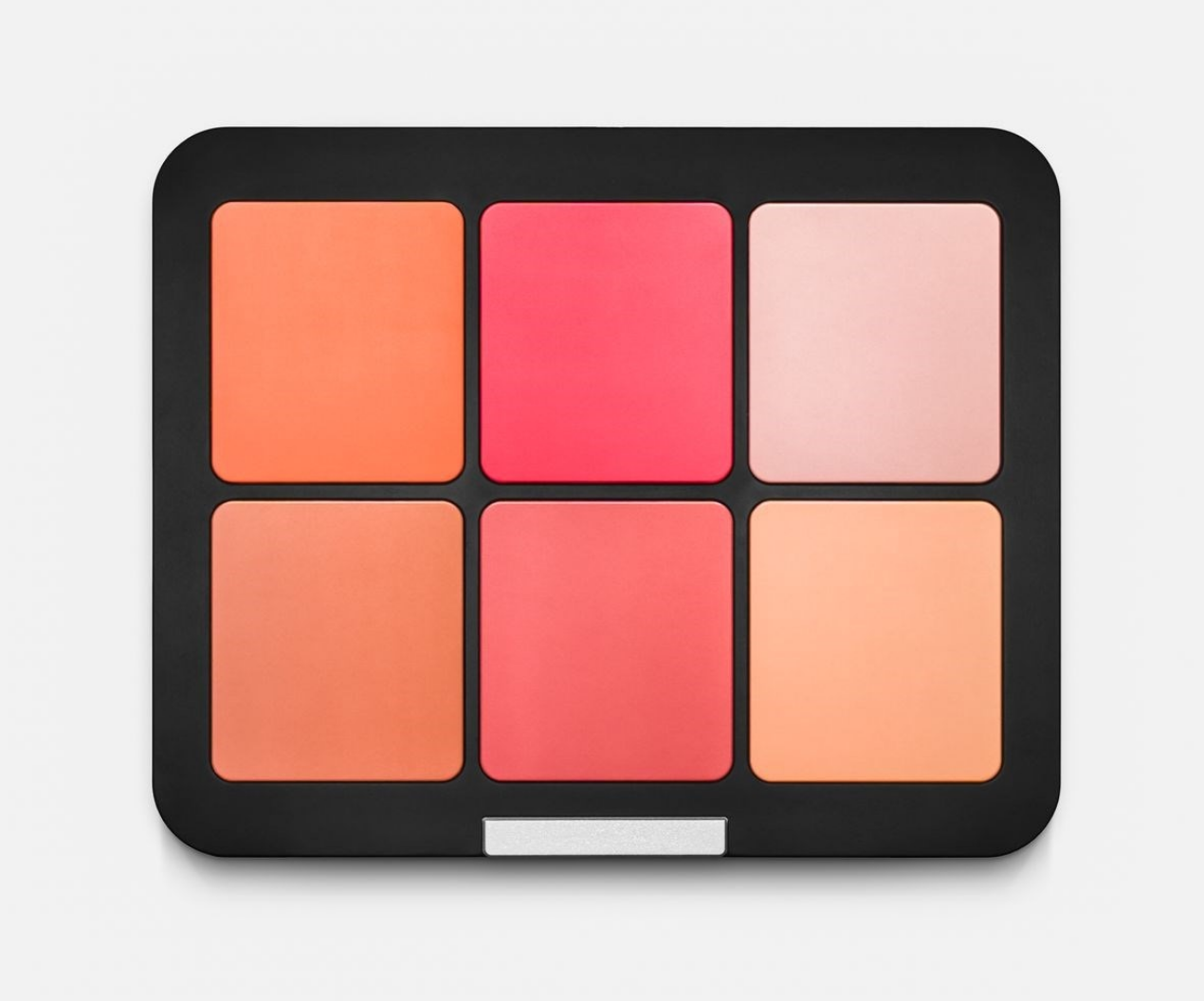
(image from artsy.net)
The makeup paintings also highlight the parallel between consumerism and the heightened commercialization of fine art. "We have become accustomed to looking, inspecting, admiring, desiring commodities that this kind of looking may inadvertently transfer to looking at art," notes Queryanne. Indeed, the authors of "M(Art)Worlds: Consumer Perceptions of How Luxury Brand Stores Become Art Institutions" discuss how many stores have appropriated museum layouts, displaying their wares as in an art gallery. "Objects for sale are displayed alongside actual art, rendering both products equivalent." While Fleury may be critiquing the overlap of stores and museums, a more cynical view is that ultimately she is profiting from the idea. The artist "can claim she’s providing a clever criticism while also reaping the rewards of their sales." The blurred lines between art and commodity can sometimes be interpreted as hypocrisy on the part of artists like Fleury whose work centers on issues of consumerism. It should be noted that in 2018 Fleury collaborated with artisanal belt purveyor J. Hopenstand to design a leather belt featuring interchangeable eyeshadows as well luxury as lipstick brand La Bouche Rouge, creating 4 shades of lipstick to be sold alongside sweatshirts quoting Gloria Steinem. Writes Lindsay Preston Zappas for Art Review, "Fleury offers us the lip shades of the season, and the feminist aphorism to match…[The] compact mirror and high heel are celebrated as weapons of war. That these symbols may have been opposed by a strain of feminism that rejected symbols of a certain ideal of femininity – high heels and makeup among them – further Fleury’s output. As if through owning conventions of beauty one might find a kind of punk-rock freedom."
 (images from jhopenstand.ch)
(images from jhopenstand.ch)
While I don't think owning makeup is necessarily an act of feminist empowerment, for the most part I see little issue with artists collaborating to sell everyday objects; as I've said many times before, makeup and other consumer goods are a way to discover various artists, and an affordable means of owning their art. Paintings that are only accessible via museums (or through being a billionaire) can now sit on your vanity, your desk, in your kitchen cupboard, or hang in your closet. In Fleury's case, it's not as though most can afford one of her paintings (or the $2,500 belt, really), so a fancy lipstick is a somewhat satisfactory substitute.
In another art/commodity crossover, makeup artists and designers have borrowed Fleury's work for their own products. Aaron de Mey discusses the inspiration for his 2009 Pink Irreverence collection for Lancome: "Pink Irreverence is all about opposites and extremes—blacks and pinks, clashing colors and textures. I wanted to show that a collection based around a traditional beauty color such as pink could be surprising. Surprise is everything I'm about…In creating Pink Irreverence, I was inspired by everything from the punk culture of London in the 70s to the work of artist Sylvie Fleury, to the rose, which is the symbol of Lancome and New Zealand, where I'm from." Five years later, Prabal Gurung revealed that the gold pattern on the packaging for his MAC collection was taken from "the subversive beauty of Sylvie Fleury's gold-plated trash cans."
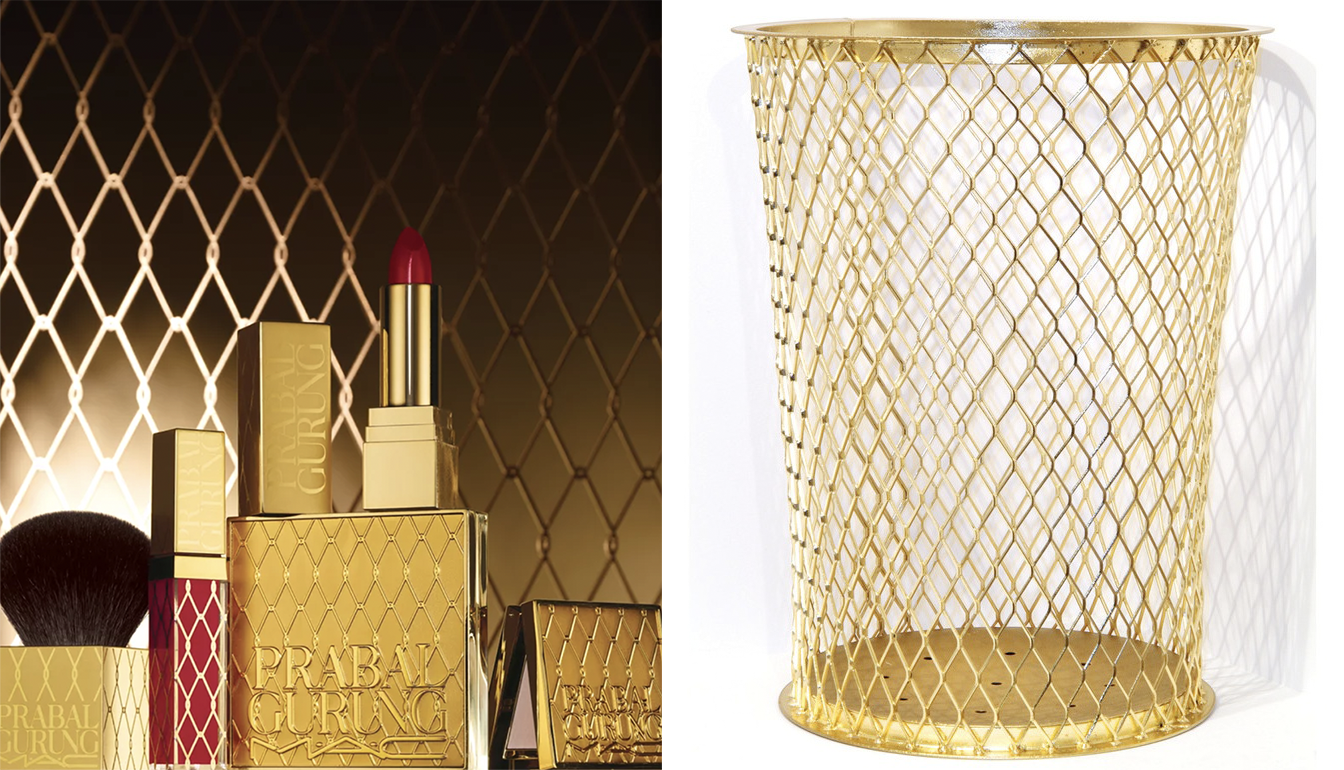 (images from popsugar.com and beyerprojects.com)
(images from popsugar.com and beyerprojects.com)
Perhaps the ultimate meeting of the fashion and beauty industry with the art world comes in the form of Fleury's color selection. Instead of using Pantone colors or nature-based hues, the artist prefers the shades found in fashion magazines and makeup products. "When I started doing installations, I was very fond of the practice of doing wall paintings and painting the pedestals. My work often dealt with fashion, so I would pick a favorite color for my show that you could find in the fashion world, whatever was in season. In the '90s, I had to send my information by fax to the galleries; for a wall painting, let’s say, I would send the typeface and the color. I never liked using the Pantones, so I would always use [my own] system—which is that magazines travel all around the world, and so does makeup. I would say, 'I would like the wall to be beige,' and then I would give the number and the brand of a foundation, and get the painter to go and buy it. Or I would say, 'The letters should be the same yellow as the bathing suit on page 92 of American Vogue for April.' Painters have palettes; I use makeup colors." This is yet another example of the blurring between cosmetics and art. The irony, of course, is that the concept has since been reversed and used to sell makeup.
Of all the artists featured in the Makeup as Muse series, I believe Sylvie Fleury most thoroughly explores the overlap of makeup and fine art. While I think I've presented a fairly in-depth discussion of her recent work, some questions remain: first, where does race fit in within these paintings? Take, for example, last year's Best of Me (Vanilla Cream). Gender has always been the main theme in Fleury's work, but it's interesting to consider what her take would be on the intersection of race, art history and the makeup industry – particularly through the lens of the food-inspired names that are ubiquitous for shades intended for deep skin tones, as she often uses the product names in her titles.
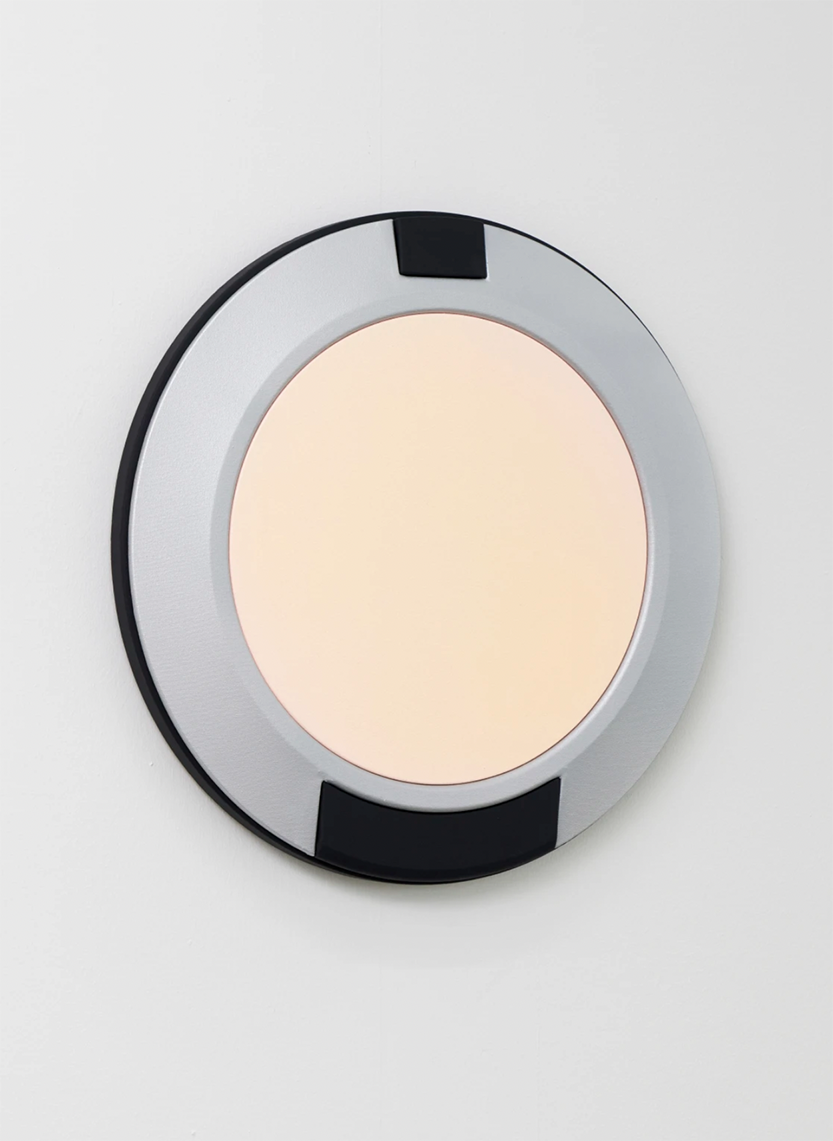
(image from karmainternational.ch)
Also, how does she avoid copyright infringement lawsuits from Estée Lauder and the like? Perhaps because her art is so entwined with the products and their marketing, makeup companies may see it as another form of advertising.
What are your thoughts? Though I am totally surrounded by makeup, I would absolutely love to have at least one of these hanging up on my walls! My other dream is to have a whole Makeup as Muse exhibition that features all of the artists discussed to date in the Museum's blog series, plus many others. 🙂
1Fleury adds that it's the composition of a particular makeup item that appeals to her and its ability to fit within her artistic practice. "I'm not reproducing the ones that I use or that I love the most. I'm reproducing the ones that strongly call to me because they look like miniature artworks and the ones that fit my purpose." Ma, Fiona. 2019. "Fashion Scoops: Makeup as Art." Wwd, Apr 08, 19. https://www.proquest.com/magazines/fashion-scoops-makeup-as-art/docview/2312169129/se-2.
2See Linda Nochlin's groundbreaking 1971 essay, "Why Have There Been No Great Women Artists?"
3"[It] is unclear whether consumerism, branding, and commodification is being celebrated or condemned. Yet, it is clearly asking its viewer to contemplate the dynamics of art's relationship with consumer culture." Serota, Kaitlin Leigh. 2017. "Art & Cultural Capital: The Economics of Art Investment." Order No. 10282887, Dartmouth College. https://www.proquest.com/dissertations-theses/art-amp-cultural-capital-economics-investment/docview/1949711081/se-2., p. 63-64
Fleury herself states, "There is an ambivalence in my work. I have a tendency to contradict myself, and I don’t mind that. I fear things that make too much sense."
4Barbara Hess, "Sylvie Fleury: The World as a Shopping Basket," in Women Artists in the 20th and 21st Century, ed. Uta Grosenick, Koln: Taschen, 2001, p. 137.
5Gawronski, Alexander. 2021. "Art as Critique Under Neoliberalism: Negativity Undoing Economic Naturalism." Arts 10 (1): 11, p. 6. doi:https://doi.org/10.3390/arts10010011.
6Queyranne, Laetitia. 2012. "Displays of Desire: The Interrelationships between Art, Display and Consumer Culture." Order No. 1514975, Sotheby's Institute of Art – New York. https://www.proquest.com/dissertations-theses/displays-desire-interrelationships-between-art/docview/1032785380/se-2, p. 55.


